MediumFormat
Latest
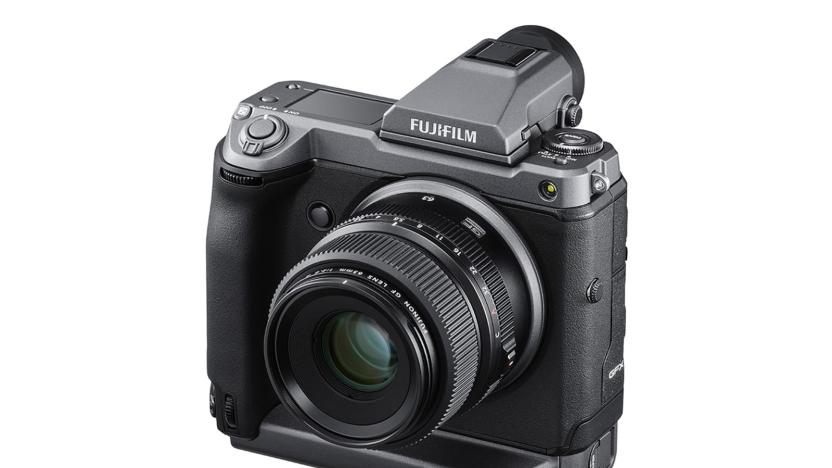
Fujifilm launches the groundbreaking 102-megapixel mirrorless GFX100
While there are four full-frame mirrorless cameras battling it out for supremacy, Fujifilm is content to stick with APS-C and medium-format. Now, it has announced that its impressive flagship medium-format camera, the 102-megapixel GFX100, will soon go on sale. On top of the insane resolution -- the highest of any mirrorless or medium-format mirrorless camera -- the GFX100 has some seriously impressive specifications. The sensor is back-side illuminated, so you'll be able to crank up the ISO and capture clean images in low light. Fujifilm said it's the first medium-format camera with full-coverage phase-detect autofocus, with subject tracking and face/eye detection. Thanks to that system, it'll shoot up to to 210 percent faster than the contrast AF-equipped GFX 50R.
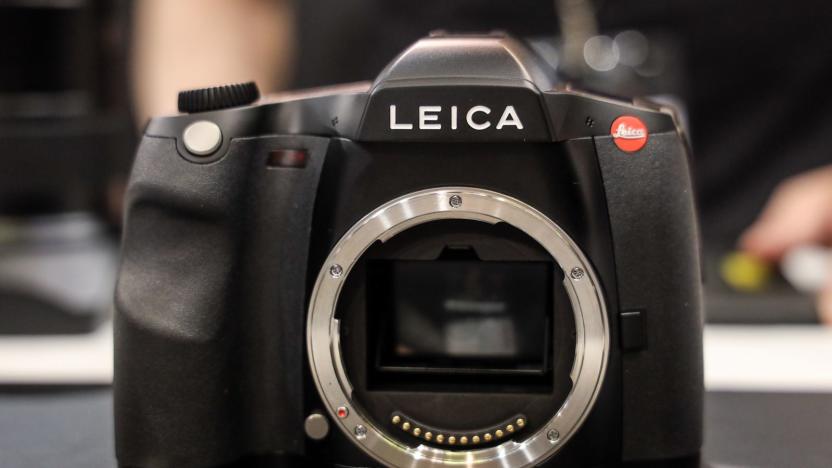
Leica's S3 is a slick, 64-megapixel medium format DSLR
Leica's biggest news of Photokina was the launch of the L-Mount alliance with Panasonic and Sigma, but it also unveiled a camera. The Leica S3 is a rakish DSLR with a massive 64-megapixel medium-format sensor and 4K video capability that's set to arrive in spring of 2019. I got a chance to handle it at Photokina 2018 and take a few shots (but not keep them), and I can tell you that this is one beautiful-feeling camera. Given the likely price, however, I'm quite sure I'll never own one.

A closer look at Fujifilm's GFX 50R and GFX 100 medium format cameras
We knew coming into Photokina 2018 that Fujifilm had some big plans for the event, and the company did not disappoint with its announcements. Aside from introducing the Instax Square SQ20, Fujifilm's had two major reveals at the show: the GFX 50R and GFX 100. These are medium format mirrorless cameras, powered by system Fujifilm likes to call Super Full Frame, that come with large sensors and a hefty price tag. The GFX 50R, for starters, is essentially a successor to the GFX 50S from 2017, which was $6,500 when it launched. Inside, it's nearly identical to the 50S, sporting a 51.4-megapixel sensor, 100-12,800 ISO range a 400-shot battery capacity and a weather-sealed body.

Fujifilm shows off an insane 100-megapixel medium format camera
The GFX 50R isn't the only new camera Fujifilm is unveiling at Photokina 2018. As rumored, the company has also introduced the GFX 100, a ridiculous 100-megapixel medium format mirrorless shooter. Fujifilm says that its GFX 100 will be the world's first medium format and mirrorless camera with a 100-megapixel sensor, and it will have in-body image stabilization and 4K video.

Phase One stuffs a 151-megapixel sensor into a medium format camera
Many of the medium format cameras that shoot at well over 100 megapixels tend to achieve those high resolutions through multi-shot techniques rather than upping the resolution of the sensor itself. Phase One, however, is turning to brute force. Its new XF IQ4 camera system revolves around a 151-megapixel backside-illuminated sensor that should capture the finest details of a portrait without any extra tricks. This also uses a new platform that moves the imaging processor into the main digital camera back, giving you RAW image editing and processing right on the device.
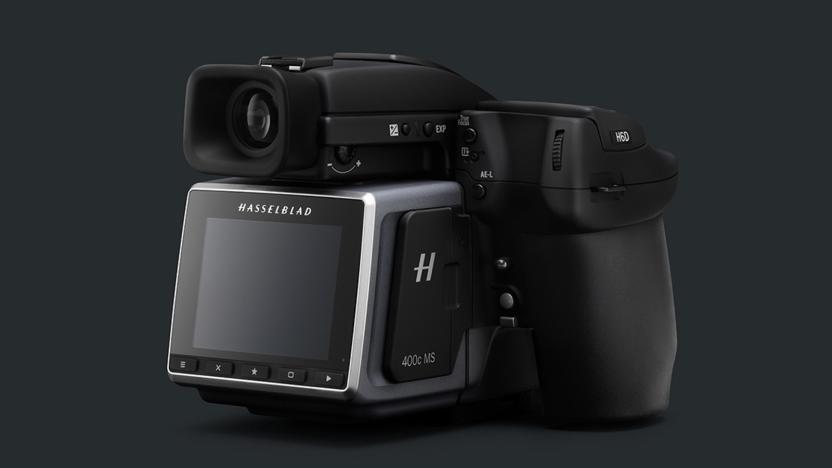
Hasselblad's crazy 400-megapixel camera does have a purpose
If you judge cameras by megapixels and dollar signs, then Hasselblad just introduced the ultimate model. The H6D-400c can shoot 400-megapixel photos and will cost you $48,000, the price of a well-equipped Tesla Model 3. It does so by combining up to six different exposures from its 100-megapixel, medium-format 53.4 X 40.0mm sensor in a process it calls "Multi Shot." Each image is shifted by a pixel, creating a much-higher resolution image, similar to how Pixel Shift works on Sony's A7R III mirrorless camera.
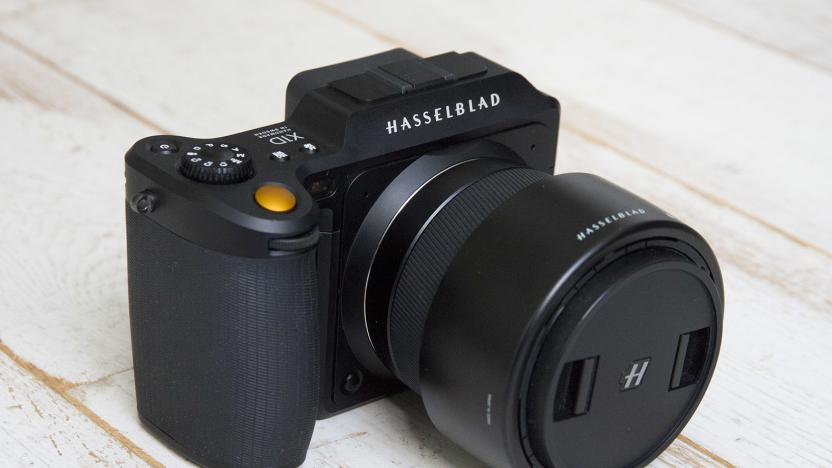
A week with Hasselblad's agile medium-format mirrorless camera
Paris is a magical place if you have the right partner, and who better than Hasselblad's X1D? The first-ever medium-format mirrorless camera (available in silver or black) is slim, stunning and easy to bring anywhere. Yes, it's costly as hell, but for the right kind of buyer, $9,000 (plus thousands more for lenses) is actually a bargain. I took it for a spin to see how it handled on the streets, and it was both a breeze to use and produced phenomenal images in all kinds of conditions.
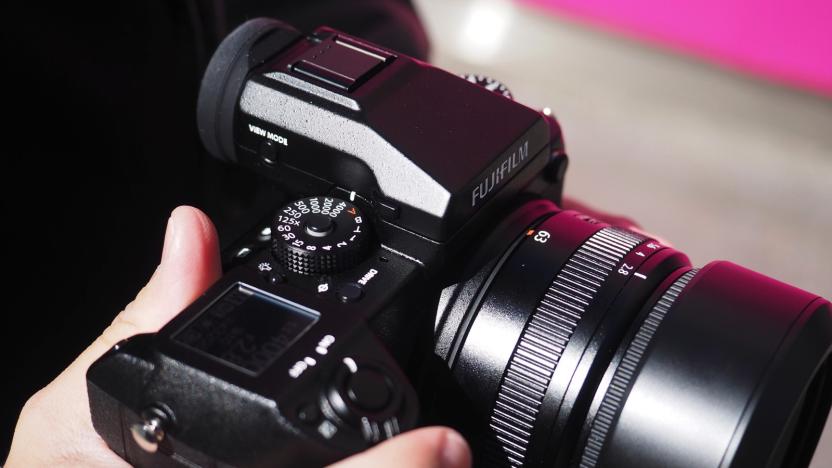
A week with Fujifilm's GFX 50S medium-format mirrorless camera
Fujifilm surprised the camera world last year with the introduction of the GFX 50S, its first medium-format mirrorless. The shooter, which is now available for $6,500 body only, packs a large 51.4-megapixel CMOS sensor (43.8 x 32.9mm) in a DSLR-like frame that only weighs 1.6lbs (740g). If you've ever used a Fuji before, its ergonomics should be familiar, thanks in large part to the company's trademark physical dials and generally premium build. What powers the GFX 50S is the latest X-Processor Pro, the same imaging chip found on Fujifilm's flagship X-Pro2 and X-T2 cameras.
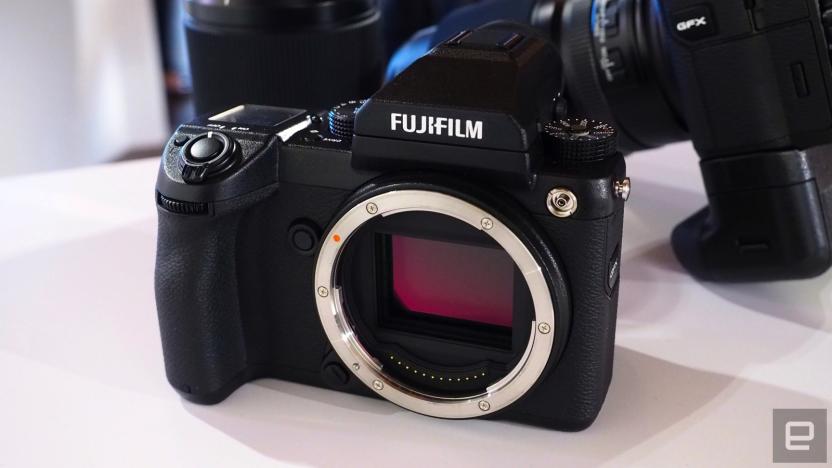
Fujifilm's GFX 50S pairs a huge sensor with a DSLR-like body
Fujifilm is kicking off 2017 with the launch of its first medium-format mirrorless camera, the GFX 50S. As we reported yesterday, the new shooter comes with a giant 51.4-megapixel CMOS sensor (43.8 x 32.9mm), the same image processor as the X-Pro2 and X-T2, as well as a 117-point autofocus system. You won't find any 4K video features here, however; the device is limited to 1080p recording at up to 30fps. Still, people are probably more interested in the GFX 50S' still photography capabilities anyway.

Fujifilm's GFX 50S medium-format mirrorless camera costs $6,500
We've known since last year that Fujifilm was working on the GFX 50S, a mirrorless camera with a medium-format sensor. But, until now, the manufacturer hadn't said how much it would cost or when it would be up for grabs. Thankfully for those of you who are interested, Fujifilm has announced that its GFX 50S is set to hit stores in "late" February for $6,500 (body-only). While that price may seem steep, it's considerably lower than a competitor like Hasselblad's X1D, which sells for roughly $9,000.

30 minutes with Fujifilm's medium-format mirrorless GFX 50S
Fujifilm made the biggest splash at Photokina with the GFX 50S, a mirrorless camera with a giant sensor stuffed into a fairly compact body. When it arrives early in 2017, the company will be in the weird position of having APS-C and medium-format cameras, but no full-frame model. So, it's a big risk: Fujifilm is introducing a new format, complete with brand new lenses, and hoping that the market is open to the idea.
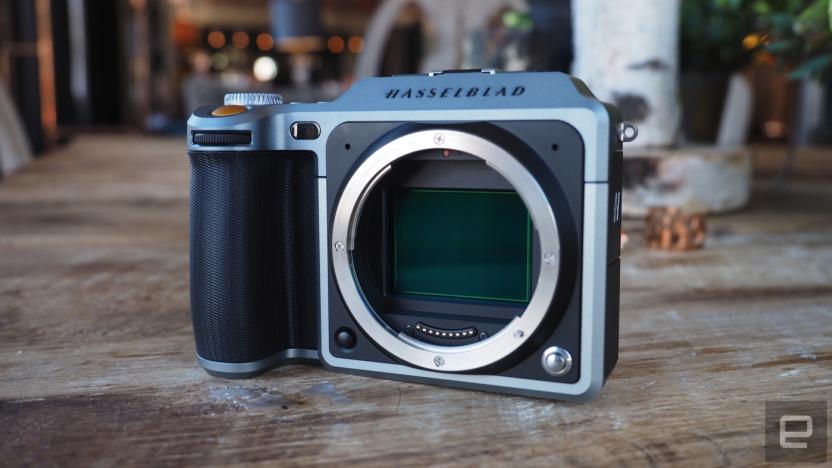
Hasselblad's X1D is a medium-format mirrorless camera
Yes, the rumors were true: Hasselblad has been working on a world's first type of mirrorless camera. Today, the Swedish company officially took the wraps off of its X1D, a compact shooter with a massive 50-megapixel, medium-format CMOS sensor. That is the largest sensor we've seen on a mirrorless camera to date, opening up the category to a whole new class of enthusiasts. What's also impressive is how light the X1D is, weighing only 725 grams (roughly 1.5 lbs) without a lens attached.

Phase One launches a true 100MP medium format camera
Taking medium format photos above 60 megapixels has typically required some trickery, like shooting multiple pictures at a time. However, you won't have to 'cheat' with Phase One's new XF 100MP camera system. As the name suggests, the hardware uses a full-fledged 100-megapixel CMOS sensor (co-developed with Sony) that captures a massive amount of detail in one shot. Moreover, the output will be more likely to please you if you still prefer film. This is the first CMOS sensor to output richer 16-bit color, and Phase One is promising a natural look that you sometimes miss from 14-bit cameras. You don't have to shoot in perfect lighting, either, since it produces "clean" shots from ISO 50 all the way to ISO 12,800.

DJI buys stake in high-end camera firm Hasselblad
Drone maker DJI has purchased a stake in Hasselblad, the company best known for medium-format still cameras and pimped out, overpriced Sony rebadges. The move is a bit of a head-scratcher, because we don't see a lot of synergy there -- Hasselblad's H-series cameras are far too heavy for drones and most models don't even shoot video. Furthermore, DJI recently unveiled its own drone-ready Micro-Four-Thirds camera. Nevertheless, DJI can certainly afford the minority share it purchased in Hasselblad, and now sits on the company's board of directors.

Crashing this 80-megapixel drone camera is a $60K mistake
Phase One has debuted what it's calling "the world's smallest" 80-megapixel medium format camera. The Phase One iXU 180 weighs just two pounds and its body is barely bigger than the Schneider-Kreuznach lense it's attached to. That means the entire rig is light enough to fit aboard the gyroscopes of most commercially available quadcopters and ultralight UAVs. What's more, the IR-capable iXU 180 can be employed as either a standalone device akin to a GoPro or as part of a multi-camera array.

You can make a 143-megapixel camera using a scanner
Scanners are really extra-large image sensors at heart, so it stands to reason that you could make a decent camera out of one. Right? Well, Dario Morelli just proved it... and then some. His homebrew medium format camera uses parts from an Epson V30-series scanner to take enormous 143-megapixel photos whose resolution puts even the better professional cameras to shame. Morelli went so far as to repackage everything in a custom enclosure, so the device is relatively portable and will sit on a tripod.

Leica's medium-format S shoots 4K video, 37.5-megapixel stills
Leica's ready to jump on the professional video bandwagon, releasing its 4K-capable S here at Photokina in Cologne, Germany. The 37.5-megapixel camera sports a medium-format sensor that's just a hair larger than full-frame, giving you a crop factor of 0.8x. It can snap 3.5 frames per second in a continuous-shooting mode, 1080/30p video and 4K clips at 24 fps. You can capture 42MB RAW files or 37.5, 9.3 or 2.3-megapixel JPGs, but if you're spending €20,230 ($25,400 in the US) on a camera (body only), you better be shooting RAW.

Hasselblad stops production of V System cameras (updated)
Almost by definition, Hasselblad is a company steeped in tradition -- it's hard to be ultra-trendy when your camera systems cost as much as a new car. We shouldn't be surprised, then, that the company is only just getting around to halting production on its last V System camera, the 503CW, 17 years after the first models rolled off the assembly line. Interest has simply dropped off quickly in the past five years, the company says. Support will continue, and accessories will sell while they last, but the emphasis from now on will be squarely on digital-first H System cameras like the H5D. Whether or not you're mourning the loss, there's no question that the V System has survived a lot during its lifetime, including the transition to digital shooting and new management. We'd say it's worth pouring one out for a true veteran of medium format photography. Update: Just to clear the air, the 503CW has been in production for 17 years -- the V System in any form has been active since 1957, since before digital was even a twinkle in Hasselblad's eye.

Leica reveals S-System medium format digital photography lineup
Leica wasn't about to let everyone else hog the spotlight at Photokina this year. The company took the wraps off more products than you could possible cram into one post (or two, or three...). But among the more intriguing is certainly the new S-System -- an update its pro-series medium format line. The sensor and accompanying board have all been refreshed, with the 30 x 44mm sensor cramming 37.5 megapixels into its expansive CCD surface. The 16-bit color depth is complimented by a wide ISO range of 100 to 1600, which should cover you for almost any imaginable application. A dual shutter design gives photographers the choice between the camera's built in shutter or the integrated one on the CS lens line, which allow for flash sync at shutter speeds as high as 1/1,000 of a second. Leica is touting the improved speed of its medium format internals, but with the ability to capture just 1.5 fps in continuous mode, it might not be the ideal action shooter. Still, the ability to capture 32 consecutive RAW images at full resolution, thanks to the 2GB of buffer memory, is quite impressive. The digital viewfinder is a three-inch LCD, capable of displaying 16 million colors representing the full sRGB color space. Of course, the VGA resolution isn't anything to write home about, but it should get the job done. The integrated two axis leveler, displayed on the viewfinder, should help avoid oddly angled portraits, while the integrated GPS receiver will let you keep track of every remote mountaintop you capture in full resolution majesty. Of course, no new camera product line would be complete without some lenses as well. In total four are launching alongside the new body, including the first zoom (30-90 MM F/3.5-5.6) and tilt/shift (120 MM F/5.6) members of the family. Rounding out the lineup is a 24mm superwide angle lens and a close-up accessory that shortens the focal length of one of the existing mounts by about three and a half feet. For more info, check out the source link.

Hasselblad H5D coming December with new focus system, design, up to 60 megapixels
Medium format camera fans, brace for impact: there's a new Hasselblad coming. The H5D supercedes the ages-old H4D with a True Focus II system that -- we're told -- is both more accurate and immediately confirms its lock. Hasselblad has also reworked the body for a more rough-and-ready feel, giving the H5D bigger controls, an extra-bright viewfinder and better weatherproofing. A new RAW + JPEG capture mode, improved wide-angle-to-macro lens conversion and a fresh 24mm f/4.8 lens have also been added to tempt studio photographers. If all this sounds alluring, H5Ds will be available in 40-, 50- and 60-megapixel versions (plus 50- and 200-megapixel Multi-Shot variants) this December. We likely won't know the effect on our bank accounts until at least a September 18th media event, but we wouldn't assume any kind of populist pricing -- Hasselblad's tendency towards five-digit figures may limit any first-hand exposure to a rental.





